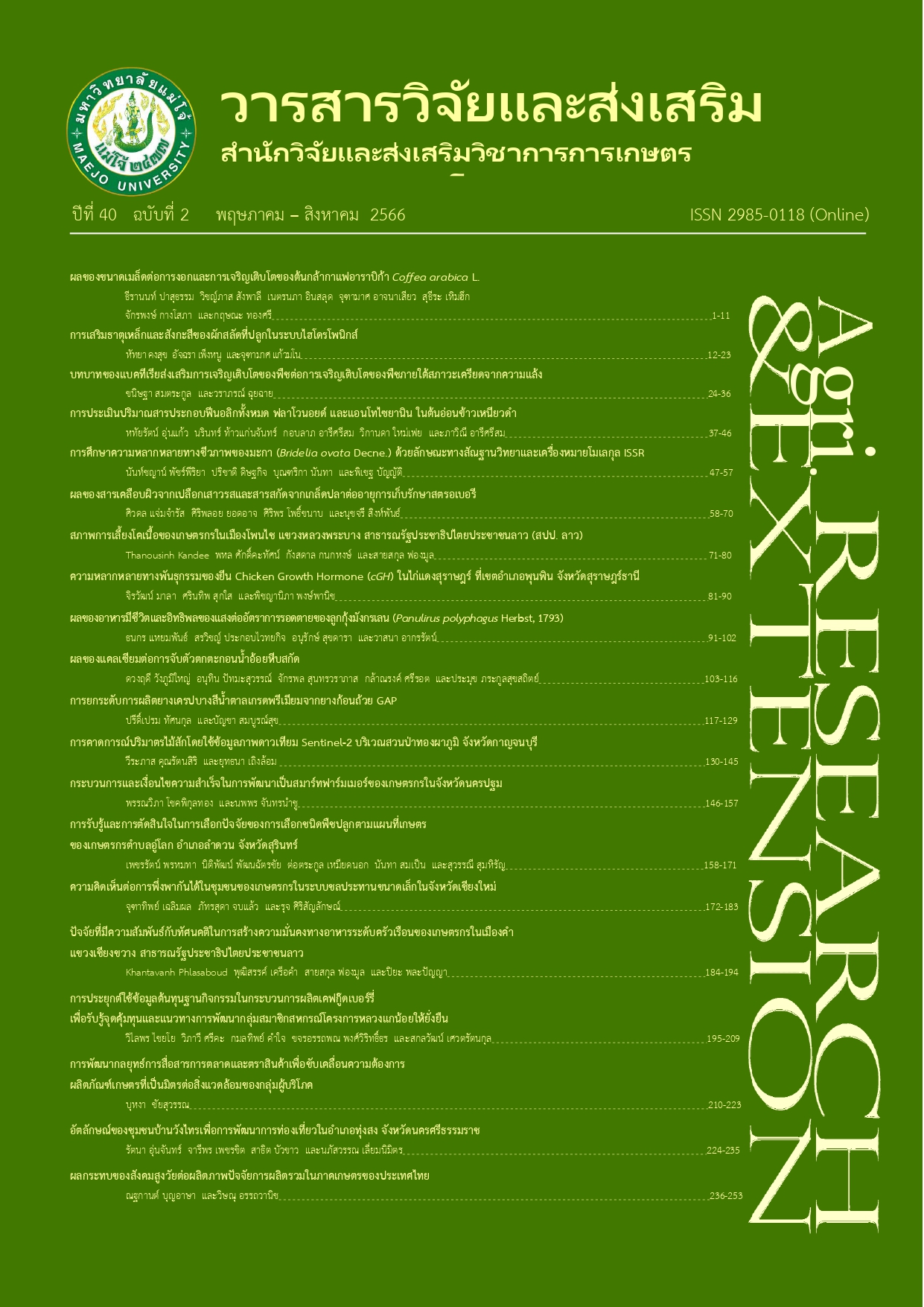ผลของขนาดเมล็ดต่อการงอกและการเจริญเติบโตของต้นกล้ากาแฟอาราบิก้า Coffea arabica L.
คำสำคัญ:
ขนาดเมล็ด, การงอก, การเจริญเติบโต, ต้นกล้ากาแฟบทคัดย่อ
การคัดเลือกขนาดเมล็ดพันธุ์กาแฟอาราบิก้าก่อนนำไปเพาะเมล็ด เป็นวิธีที่อาจนำไปใช้เป็นแนวทาง ในการผลิตกล้ากาแฟอาราบิก้าให้กับเกษตรกร โดยมีการตั้งข้อสังเกตว่าเมล็ดพันธุ์ที่มีขนาดแตกต่างกันส่งผลต่อการงอก และการเจริญเติบโตของต้นกล้า แต่ยังไม่พบรายงานในพืชกาแฟอาราบิก้า ดังนั้นจึงได้ทำการศึกษา ผลของขนาดเมล็ดต่อการงอกและการเจริญเติบโตของ ต้นกล้ากาแฟอาราบิก้า โดยสุ่มเก็บผลกาแฟเชอร์รีที่ปลูกภายใต้เรือนยอดป่าธรรมชาติแบบเจาะจง (Purposive sampling) จำนวน 4 แปลง แปลงละ 600 เมล็ด มาชั่งน้ำหนักและวัดขนาดของผลกาแฟเชอร์รี แล้วทำการแบ่งขนาดเมล็ดโดยใช้น้ำหนักเมล็ดเป็นเกณฑ์ แบ่งได้เป็น 3 ขนาด ได้แก่ ขนาดใหญ่ หรือน้ำหนักเมล็ด >2.21 กรัม ขนาดกลาง น้ำหนักเมล็ด 1.43 - <2.21 กรัม และขนาดเล็ก น้ำหนักเมล็ด <1.43 กรัม นอกจากนี้เมล็ดกาแฟทั้งหมดยังถูกแบ่งเกรดตามกระทรวงเกษตรและสหกรณ์ โดยใช้ความกว้างของเมล็ดเป็นเกณฑ์ แบ่งได้เป็น 7 เกรด จากนั้นนำเมล็ดไปเพาะทดสอบการงอกในโรงเรือน และติดตามการเจริญเติบโต ผลการวิจัยพบว่า ความแตกต่างระหว่างขนาดเมล็ดพันธุ์ทั้งน้ำหนักหรือความกว้าง ไม่ส่งผลต่อการงอก ดัชนีการงอก วันงอกเฉลี่ยของเมล็ด และการเจริญเติบโตของต้นกล้า ดังนั้นการศึกษาครั้งนี้ทำให้ได้เห็นว่าเมล็ดกาแฟอาราบิก้าขนาดเล็กที่ถูกขายเป็นเมล็ดตกเกรดราคาถูก สามารถนำไปใช้ประโยชน์ในการเป็นเมล็ดพันธุ์ได้ ซึ่งเป็นการลดการสูญเสียรวมถึงลดต้นทุนในทางธุรกิจเมล็ดพันธุ์ได้อย่างมาก และเป็นการใช้ประโยชน์จากเมล็ดกาแฟให้เกิดประสิทธิภาพสูงสุด
เอกสารอ้างอิง
Chacón, P., R. Bustamante and C. Henriquez. 1998. The effect of seed size on germination and seedling growth of Cryptocarya alba (Lauraceae) in Chile. Revista Chilena de Historia Natural 71(2): 189-197.
Department of Agriculture. 2019. Manual for Arabica Coffee Production Management. 2nd ed. Bangkok: Karanti. [in Thai]
Department of Agriculture Extension. 2014. Programming Optimization of Arabica Coffee. 1st ed. Bangkok: The Agricultural Cooperative Federation of Thailand Limited. 152 p. [in Thai]
Díaz, S.V., A.F. Morales, A.F. Palacios and I.P. Arango. 2015. How does the presence of endosperm affect seed size and germination. Botanical Sciences 93(4): 783-789.
Eira, M., E. Amaral da Silva, R. De Castro, S. Dussert, C. Walters, J. Bewley and H. Hilhorst. 2006. Coffee seed physiology. Brazilian Journal of Plant Physiology 18(1): 149-163.
Estanislau, W.T. 2002. Modelo Funcional de Desenvolvimento de Sementes de Cafeeiro (Coffea arabica L.). Doctoral Dissertation. Uni-versidade Federal de Lavras. 123 p.
ISTA. 1979. Handbook for Seedling Evaluation. Zurich: The International Seed Testing Association. 134 p.
Kaveeta, L. 2016. Plant Structure. 2nd ed. Bangkok: Department of Botany Kasetsart University. 150 p.
Moraris, H., P. Caramori, A.M. Ribeiro, J.C. Gomes and M.S. Koguishi. 2006. Microclimate characterization and productivity of coffee plants grown under shade of pigeon pea in Southern Brazil. Pesquisa Agropecuária Brasileira 41(5): 763-770.
Mtambalika, K., C. Munthali, D. Gondwe and E. Missanjo. 2014. Effect of seed size of Afzelia quanzensis on germination and seedling growth. International Journal of Forestry Research 2014(384565): 1-5. [Online]. Available https://doi.org/10.1155/2014/384565 (November 22, 2022).
Muschler, R.G. 2001. Shade improves coffee quality in a sub-optimal coffee-zone of Costa Rica. Agroforestry Systems 51(2): 131-139.
Office of the Conservation Area Management 16. 2014. The royal initiative project Ban Khun Tae, Doi Kaeo subdistrict, Chom Thong district, Chiang Mai province. [Online]. Available https://www.chiangmai.go.th/project/kuntae.html (September 2, 2021).
Paz, H., S.J. Mazer and M. Martínez-Ramos. 1999. Seed mass, seedling emergence, and environmental factors in seven rain forest psychotria (Rubiaceae). Ecology 80(5): 1594-1606.
Powell, A.A., L.J. Yule, H.-C. Jing, S.P.C. Groot, R.J. Bino and H.W. Pritchard. 2000. The influence of aerated hydration seed treatment on seed longevity as assessed by the viability equations. Journal of Experimental Botany 51(353): 2031-2043.
Romero-Alvarado, Y., L. Soto-Pinto, L. Garcia-Barrios and F. Barrera-Gaytan. 2002. Coffee yields and soil nutrients under the shades of Inga sp. vs. multiple species in Chiapas, Mexico. Agroforestry Systems 54(3): 215-224.
Sakhamula, T. and B. Siri. 2011. Effect of seed size on germination and seedling growth of maize. Khon Kaen Agriculture Journal 39(Suppl.): 98-103. [in Thai]
Samreen, S. and S. Shaukat. 2000. Effect of seed size on germination, emergence, growth and seedling survival of Senna occidentalis Link. Pakistan Journal of Biological Sciences 3(2): 292-295.
Souza, M.L. and M. Fagundes. 2014. Seed size as key factor in germination and seedling development of Copaifera langsdorffii (Fabaceae). American Journal of Plant Sciences 5(17): 2566-2573.
Sualeh, A. and J. Dawid. 2014. Relationship of fruit and bean sizes and processing methods on the conversion ratios of arabica coffee (Coffea arabica) cultivars. Time Journals of Agriculture and Veterinary Sciences 2(2): 70-74.
Wattanaphut, N. 1999. Plant Propagation. Bangkok: O.S. Printing House. 447 p. [in Thai]
Wetchakama, N. and P. Khaengkhan. 2018. Improvement of seed qualities with seed priming techniques. Prawarun Agricultural Journal 5(1): 17-30. [in Thai]
ดาวน์โหลด
เผยแพร่แล้ว
รูปแบบการอ้างอิง
ฉบับ
ประเภทบทความ
สัญญาอนุญาต
ลิขสิทธิ์ (c) 2023 วารสารวิจัยและส่งเสริมวิชาการเกษตร

อนุญาตภายใต้เงื่อนไข Creative Commons Attribution-NonCommercial-NoDerivatives 4.0 International License.
บทความนี้ได้รับการเผยแพร่ภายใต้สัญญาอนุญาต Creative Commons Attribution-NonCommercial-NoDerivatives 4.0 International (CC BY-NC-ND 4.0) ซึ่งอนุญาตให้ผู้อื่นสามารถแชร์บทความได้โดยให้เครดิตผู้เขียนและห้ามนำไปใช้เพื่อการค้าหรือดัดแปลง หากต้องการใช้งานซ้ำในลักษณะอื่น ๆ หรือการเผยแพร่ซ้ำ จำเป็นต้องได้รับอนุญาตจากวารสาร





